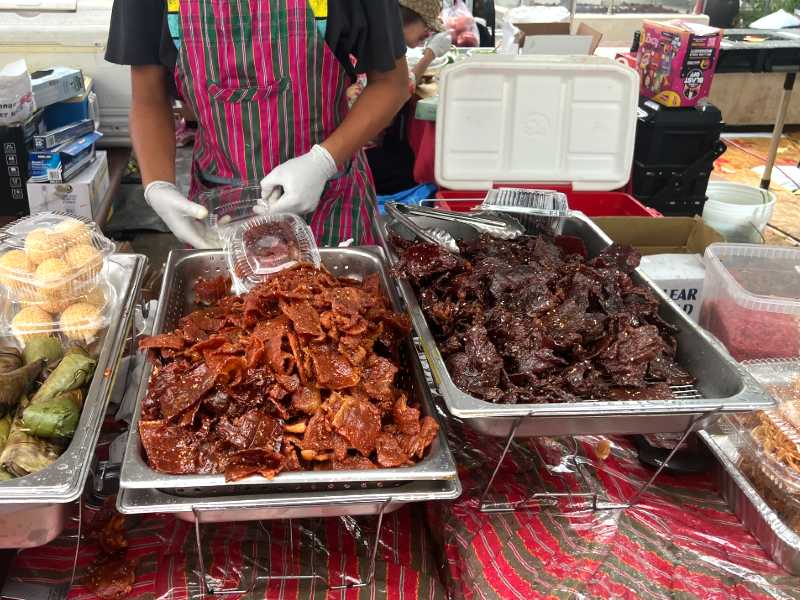A piece of beef jerky doesn’t look anything like the cow it came from. But that’s exactly what it is: pure beef that’s been dried, seasoned, and preserved into a more snackable form.
The transformation from massive animal to bite-sized treat is an incredible one, to be sure. It’s enough to make you wonder: just how many packages of beef jerky do you get from a single cow?
We can get to the bottom of this bovine mystery with a little math. Let’s calculate our way through the jerky-making process and find out!
First Things First: How Much Does a Beef Cow Weigh?
We’ll start with the cattle itself, whose weight will vary depending on many factors: age, breed, health, and diet.
Cattle Breeds and Weight

The breed is perhaps the most significant factor here, as different cattle varieties have been bred for different characteristics. Fancier breeds may look and taste more unique at the expense of weight, while heftier heifers are bred for maximum weight without care for aesthetics.
But one breed stands out among the rest as the most popular breed of meat cattle: the Angus. In fact, 60% of beef cattle in the US are Angus or Angus crosses.
The average Black Angus bull weighs 2,000 pounds at the time of slaughter. And the less-common Red Angus bull clocks in at around 1,870 pounds. Both colors produce similar meat: highly flavorful with intricate marbling.
Other common meat cattle breeds include the Hereford, which typically weighs 1,200 (cow) to 1,800 (bull) pounds at slaughter.
NOTE: Cows are female cattle and bulls are male cattle.
And many beef connoisseurs consider the Brahman one of the best-tasting breeds. Brahmans weigh in at up to 2,200 pounds at slaughter.
Cattle Diet, Age, Health, and Weight
Diet, health, and age also play a role in cattle weight. Grass-fed cattle may take longer to reach their maximum weights than grain-fed cattle, so they are often slaughtered at lower weights than grain-fed cattle.
Connect with Real Jerky Makers
Because the Best Jerky Doesn't Come from a Store
For instance, a grain-fed cow may weigh 1,400 pounds when slaughtered at 22 months of age. The same cow, if grass-fed, may weigh 1,200 pounds or less when sent to slaughter at the same age.
But many farmers consider grass-fed cattle to live healthier lives than grain-fed cattle, which improves the quality and nutritional value of the resulting beef. In fact, some grass-fed cattle farms report growth rates that exceed those from grain-fed farms: one grass-fed cow reached a weight of 1,387 pounds in just 14 months!
Grass-fed cattle tend to be leaner than grain-fed cattle, which is important for jerky making. The highest-quality beef jerky is made from lean meat, and as we’re about to see, being lean could mean retaining a greater percentage of weight at the slaughterhouse.
How Much Beef Do You Get from a Cow?

For the rest of our calculations, we’ll create a hypothetical test subject: a 2,000-pound grain-fed Black Angus bull with average fat and muscle density.
But when our bull heads to the slaughterhouse, he’ll lose around 39% of that weight to slaughter and dressing. The hooves, head, hide, blood, heart, lungs, and viscera are all removed during this process, leaving the carcass at around 61% of its original weight.
That leaves us with a 1,220-pound hanging weight — the weight of the carcass while it’s hanging on the rail at the slaughterhouse.
But we won’t end up with 1,220 pounds of beef.
While on the rail, the carcass will shrink due to moisture loss. Workers will also remove the bones and fat from the carcass.
Fat removal is particularly important since the best beef jerky is made from lean meat. The leaner the cow at slaughter time, the less weight the carcass will lose during later fat removal.
Moisture loss and fat/bone removal result in an additional 18% weight reduction, leaving us with around 43% — 860 pounds — of the original bull’s weight in butchered, usable meat.
How Much Beef Jerky Do You Get from a Butchered Cow?
So we’ve left the slaughterhouse with our 860 pounds of beef. We’ve lost more than half of the original weight to slaughter, dressing, and deboning, so our fantasies of enjoying a literal ton (1 ton = 2,000 lbs.) of beef jerky have been crushed.
But we’re not done yet! We’ve still got to turn that fresh beef into beef jerky, and that’s going to require a lot of drying.
Beef is around 60-70% water. Drying it makes the vast majority of that water evaporate, leaving us with 30-50% of the beef’s starting weight.
So when we finish drying out our beef into jerky, we’ll be left with 258 to 430 pounds of meat. We’re now down to around 15-20% of the original weight of the bull.
Beef Jerky by the Cut: Better Cuts = Better Jerky

If you’re not picky about your beef cuts, you can turn all of your beef into jerky and keep that figure where it is. Your 2,000-pound bull would net you 258 to 430 pounds of beef jerky, or 258 to 430 packages of Jack Link’s — not bad!
That’s 10-20% of the bull’s original weight.
But many cuts of beef simply don’t make for good jerky.
Fat will cause the jerky to spoil, so the short loin, rib, and other fatty cuts aren’t typically used for high-quality jerky.
Most gourmet beef jerky is made from the leanest cuts: round and flank. You can also use slightly fattier cuts like chuck, sirloin, and brisket, but you’ll need to trim the fat from them first.
So let’s say we opt to make jerky from the round, flank, chuck, sirloin, and brisket, ignoring the fattier cuts. These lean cuts comprise 40-50% of the cow by weight, so that leaves us with between 103 and 215 pounds of high-quality beef jerky.
And that means we got around 5-10% of the bull’s original weight in jerky.
That percentage doesn’t sound like much, but remember that we started with a 2,000-pound bull. Even 5% of that is more beef jerky than many people eat in a lifetime!
The Final Calculation
Using the most conservative estimates we’ve covered, every pound of live cattle translates to 0.8 ounces of high-quality beef jerky.
The more generous estimates result in 1.6 ounces of beef jerky per pound of cattle if only the leaner cuts are used for jerky.
And if you’re not picky about the quality of your jerky, one pound of cattle could produce 3.6 ounces of jerky.
If you’ve got a particular animal in mind, you can use these calculations to figure out how much jerky you’ll get based on the weight of the cow.
Or if you’ve got a particular quantity of jerky, you can use them to find out how much it originally weighed back when it was still part of a cow!
How Much Meat Is a Half Cow? (Video)
"You might be a redneck if you think that beef jerky and moon pies are two of the major food groups."
-- Jeff Foxworthy





